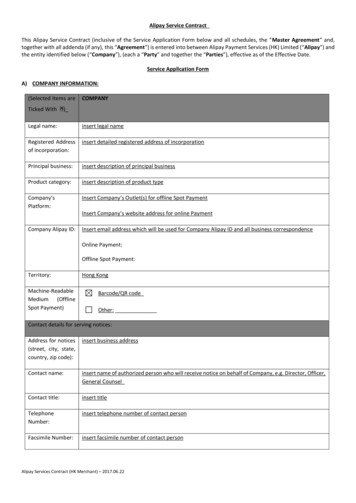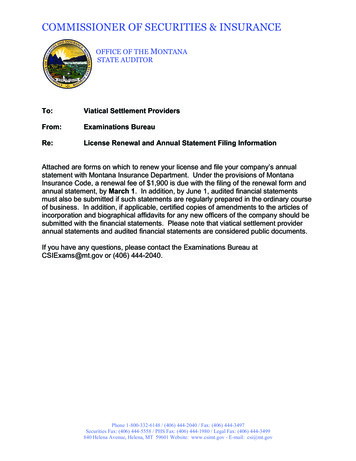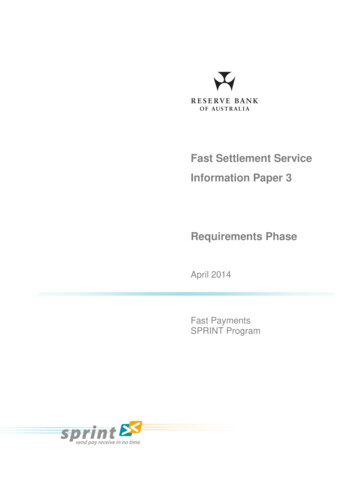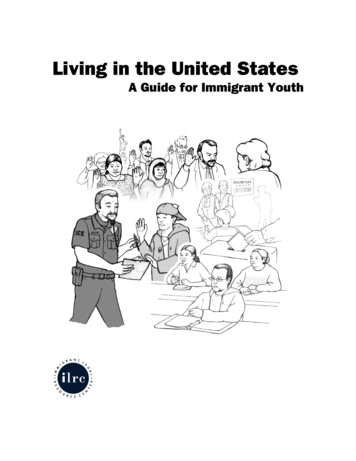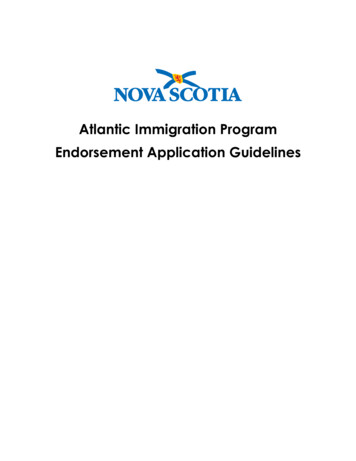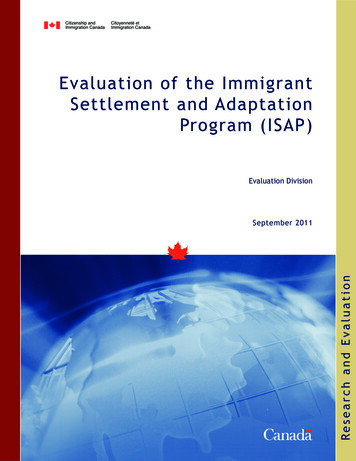
Transcription
Evaluation of the ImmigrantSettlement and AdaptationProgram (ISAP)Evaluation DivisionRe s e a r c h a n d E v a l u a t i o nSeptember 2011
Ci4-71/2011E-PDF978-1-100-19453-0Ref. No. : ER201108.01E
Table of contentsExecutive summary. iii1.Introduction . 11.1.1.2.1.3.2.Background . 1Purpose of the evaluation . 1Structure of the report . 2Overview of the ISAP Program . 3Program objectives . 3Program delivery partners . 4Budget . 4ISAP client profile . 5ISAP services . 82.1.2.2.2.3.2.4.2.5.3.4.Evaluation methodology . 103.1.3.1.1.3.1.2.3.1.3.Primary data sources .Interviews .Surveys .Focus groups .101010103.2.3.2.1.3.2.2.3.2.3.Secondary data sources .Document review .Literature review .Administrative data analysis .111111113.3.Evaluation limitations and strengths . 12Evaluation findings . 144.1.4.1.1.4.1.2.4.1.3.Program relevance .Program need .Comparable programs .Consistency with government priorities and roles and responsibilities .141415164.2.4.2.1.4.2.2.4.2.3.Program implementation .Program promotion .ISAP services .ISAP B .181819284.3.4.3.1.4.3.2.4.3.3.4.3.4.Program results .Newcomer settlement .Job search ability .Service bridging .ISAP B .30303232334.4.ISAP design . 344.4.1. Program management . 344.4.2. Capacity . 425.Conclusions . 45Appendix A: Logic model . 49Appendix B: Bibliography . 51-i-
Appendix C: Alternative delivery models . 52List of tablesTable 1-1:Table 2-1:Table 2-2:Table 3-1:Table 3-2:Table 3-3:Table 4-1:Table 4-2:Table 4-3:Table 4-4:Table 4-5:Table 4-6:Table 4-7:Table 4-8:Table 4-9:Table 4-10:Table 4-11:Table 4-12:Table 4-13:Table 4-14:Table 4-15:Table 4-16:Table 4-17:Table 4-18:Table 4-19:Table 4-20:ISAP Evaluation questions . 1ISAP Program growth . 5Characteristics of ISAP clients . 6Regional Distribution of Interview Participants . 10Number of Stakeholders Surveyed . 10ISAP Focus Groups by Location and Type of Participant . 11Methods used to promote/hear about ISAP . 18Perception of effectiveness of CIC efforts to promote ISAP . 19Clients’ reasons for approaching SPOs . 19Provision of ISAP services . 21Referral services of ISAP as reported by SPOs . 22Client satisfaction with ISAP services . 27Constraining factors to using ISAP services . 27Number of ISAP B projects, 2004/05-2008/09 . 28ISAP B activities . 28Products generated by ISAP B projects . 29Rating overall success of ISAP by groups of stakeholders . 30Rating ISAP design . 35Rating CIC monitoring mechanisms . 37Number of CIC Officers that received iCAMS training, 2004/05-2008/09. 38Number of SPO staff that received iCAMS training, 2004/05-2008/09 . 39Rating ISAP communication and information sharing . 41Tools and resources to deliver ISAP . 42Rating training of CIC officers and SPO staff . 42Rating ISAP funding . 43ISAP A growth in expenditures and services by fiscal year . 44List of -1:4-2:4-3:4-4:4-5:4-6:4-7:Comparison of ratings of CIC settlement programs .Use of ISAP after arrival in Canada .The view of SPOs on the supply and demand for iSAP services .Clients and SPO perceptions of ISAP impact on settlement needs .Clients and SPO perceptions of ISAP impact on employment .Perceptions of impact on community participation .Comparison of Number of ISAP A SPOs in SAP and iCAMS .- ii -15202131323338
Executive summaryIn operation since 1974, the Immigrant Settlement and Adaptation Program (ISAP) providedservices to facilitate the adaptation, settlement and integration of newcomers to Canada in orderfor them to participate to the best of their ability in the Canadian economy and society as quicklyas possible. ISAP had two main streams: ISAP A and ISAP B. Under ISAP A, funding wasprovided to Settlement Provider Organizations (SPOs) to deliver a variety of services, includingneeds assessments and referrals, information and orientation, para-counselling, and preemployment counselling, directly to newcomers. SPOs were also funded to engage in servicebridging with non-settlement organizations and the broader community so that these groupsbetter understand newcomer issues and become more accessible and welcoming to newcomers.ISAP B supported a wide range of projects that enhanced the ISAP services provided by SPOsto newcomers, such as research, tool development and capacity building. Between 2004/05 and2007/08 ISAP funded 204 unique SPOs across Canada. With the adoption of the modernizedapproach in 2008, ISAP and all other CIC settlement programs were merged into one singleprogram with six separate streams. Although ISAP no longer exists, many of the activitiesformerly funded under the Program continue under the modernized Settlement Programfunding.MethodologyThe objective of this evaluation is to provide an evidence-based assessment of the relevance,design, delivery, and performance of ISAP. In addition, the evaluation identifies opportunities toimprove the Program and to inform future developments. Several lines of inquiry were used tocomplete the evaluation including key informant interviews with CIC management, CIC staff,and provincial/territorial representatives; surveys with SPO managers and staff who deliveredISAP A and ISAP B projects, and with clients (814 survey respondents). In addition, focusgroups, a document and literature review, and an analysis of CIC administrative data wereconducted.Findings and conclusionsRelevanceISAP was relevant as it sought to address a wide range of settlement and adaptation needs ofnewcomers. It was unique in terms of its availability and scope, and consistent with the purviewof the federal government and CIC. However, ISAP stakeholders noted that there are diverseviews on the appropriate division of roles and responsibilities between federal and provincialpartners in the design and delivery of settlement services. The major need for ISAP was attributed to the fact that it helped newcomers address theirimmediate needs (e.g., information and orientation, health, employment), especially duringthe first few years after arrival in Canada. Although there are other programs that provide services similar to those of ISAP, nonedeliver the same breadth of services to newcomers, or is as widely available. ISAP was consistent with Government of Canada and CIC priorities, and was broadlyviewed to be consistent with the roles and responsibilities of the federal government.However, there are mixed views on the division of roles and responsibilities of the federal- iii -
and provincial partners in the design, planning and delivery of settlement programs inCanada. Some stakeholders mentioned that local involvement may help to tailorprogramming more appropriately to local conditions.ImplementationOverall the implementation of ISAP was successful and the number of services provided wasgrowing; however, there are a few areas in which the provision of ISAP-type services can beenhanced. The provision of all ISAP-type services has increased in the past five years, particularly in theareas of para-counselling services and information/orientation. As the needs assessment process was not standardized, SPOs developed and used a varietyof their own tools. While individualized tools may be appropriate, the lack of consistency inSPO approaches may also have meant that some newcomer needs were not correctlyidentified. Standardized tools and continuous assessment would be useful to ensure that thefull range of newcomer needs are consistently identified and monitored by all SPOs. Para-counselling services aim to assist newcomers in problem-solving by helping them todefine their problems and to identify resources that are available to them. There wasuncertainty among SPOs regarding the nature and scope of para-counselling services thatshould be provided through ISAP-type programs, particularly as they relate to mental wellbeing. SPO respondents cited a need for greater clarity and precision from CIC regardingthese issues.ResultsThe most prevalent positive impact of ISAP was that it improved newcomers‘ ability to identifyand address their settlement needs and to learn about other services in their community that canhelp them. ISAP services also had a major impact on helping newcomers seek and findemployment. In addition, SPOs are active in service bridging activities to improve theaccessibility of community and non-settlement organizations to newcomers. ISAP was effective in helping most newcomers understand their settlement needs, meet theirbasic daily needs, learn about other existing services in the community, and set goals relatingto settlement and adaptation. ISAP was also successful in improving the employment outcomes of participants as clientsconfirmed that it was effective in improving their job finding skills; almost half of the ISAPclients surveyed felt that participation in the Program had helped them to find a job. Almost all SPOs who participated in the evaluation have engaged in a variety of servicebridging activities with communities and non-settlement organisations. These activities haveraised awareness of newcomer issues among the broader community, and have led to thedevelopment of partnerships to support newcomers.Design and deliveryThe design and delivery of the Program were sufficiently clear; however, there are some areasfor improvement such as the need to enhance coordination between partners, invest in buildingthe capacity of delivery partners, and strengthen performance measurement.- iv -
The Coordination and development of partnerships among governments, SPOs and nonsettlement organisations is a means to provide more comprehensive and integratedsettlement services. While many partnerships were developed through the former ISAP,there are still opportunities for increased collaboration. Overall, CIC and SPOs had sufficient capacity to deliver ISAP, however there are severalareas in which capacity could be improved such as the development of up-to-date tools andguidelines, and strengthening the ability of CIC and SPO staff in various management areas. CIC lacks an approach to collect outcome data which makes it difficult to demonstrate theachievements of ISAP (and its replacement as specified in the modernized approach).Although Immigration–Contribution Accountability Measurement System (iCAMS) collectsdata on clients and the provision of services, the system‘s focus on outputs is only partiallyeffective in supporting monitoring, evaluation and decision-making. The growth in number of clients and numbers of services delivered did not keep pace withthe growth in funding (for ISAP core and other programs). Therefore, the Programappeared to be more expensive to operate. It is unknown whether this was, in fact, the case,or whether the Program was simply been unable to demonstrate its growth because ofweaknesses in the data collection systems. As ISAP included many different componentsand as the sources of data and coding system varied throughout the years, calculating theISAP expenditures for the components covered by this report was challenging. Given theissues encountered on the number of clients and services as well as the challenges related tothe information on expenditures it is not possible to assess cost-effectiveness. Aligning thefinancial system with the various components of ISAP or the particular streams of themodernized approach would enable the Department to better track ISAP-type expenditures.This in turn would provide better data in support of assessment of cost-effectiveness.-v-
1.Introduction1.1. BackgroundOriginally intended to assist families of Canadian soldiers and war refugees adjust to life inCanada, the Government of Canada established settlement services in 1948. CIC first introducedthe Immigrant Settlement and Adaptation Program (ISAP) in 1974. ISAP provided services tofacilitate the adaptation, settlement and integration of newcomers to Canada so that they couldparticipate to the best of their ability in the Canadian economy and society as quickly as possible.A detailed description of ISAP is provided in Section 2. In 2008, CIC‘s modernized SettlementProgram replaced ISAP as well as the other settlement and language training programs.Although ISAP no longer exists, many of the activities formerly funded under the Programremain eligible under the modernized Settlement Program funding.1.2. Purpose of the evaluationThe objective of this evaluation is to provide an evidence-based assessment of the relevance,design and delivery, and performance of ISAP. The evaluation examines delivery of the Programin all provinces and territories for which the federal government (CIC) has the sole or jointresponsibility for the management of settlement programs.1 The evaluation covers five years(from April 2004 to March 2009). The period extends before and during implementation of themodernized approach. Notwithstanding the merging of the programs, this evaluation focuses onthe traditional ISAP Program as per requirements outlined in the original funding arrangement.2The following table presents the evaluation issues and questions related to the ISAP Program.Table 1-1:ISAP Evaluation questionsIssuesQuestionsRelevance Is there a continuing need for this type of settlement program? Was ISAP consistent with Government of Canada and CIC priorities? Was the development and funding of ISAP an appropriate role for the Government ofCanada?Performance Were ISAP services meeting the immediate settlement needs of clients? (e.g.,banking/finances, shopping, utilities, referrals to resources) Does para-counselling and referrals to specialized services assist clients in dealing withimmediate crises and issues? Do clients who receive employment-related services gain the skills to look foremployment? Do Service Bridging initiatives contribute to businesses and community organizations,other than SPOs, being more accessible and welcoming to newcomers? Did ISAP contribute to the adaptation and integration of clients?The delivery models that were not examined as part of this study are the ones in Quebec, British Columbia andManitoba. The Canada-Quebec Accord signed in 1991 outlines Quebec‘s provincial responsibilities for immigrationand settlement, and British Columbia and Manitoba have immigration agreements that outline their responsibilitiesfor settlement.2 Other initiatives that have been subsumed under the modernized Settlement Program funding include Initiativesto Foster Immigration to Francophone Minority Communities (IFMC); Enhanced Language Training (ELT); theGoing-to-Canada Immigration Portal; and the Welcoming Communities Initiative (WCI). These initiatives are notcovered in this evaluation but will be covered in other evaluation projects.11
Design anddelivery Were there any barriers for potential ISAP clients (e.g., waiting lists, transportation,child-minding)? Was the design and implementation of ISAP activities based on sound evidence? Did program stakeholders have a clear understanding of ISAP services and objectives? Were there useful tools and information that support and improve service delivery? Did service providers have the resources (including community resources for referrals)and infrastructure necessary to facilitate service delivery? Was ISAP an effective means to meet the immediate settlement needs of newcomers? What was ISAP’s interaction with other settlement programs in achieving its outcomes?1.3. Structure of the reportThe report is organized into five main sections. Following the introduction, Section 2 describesthe ISAP Program in terms of its history, objectives, delivery, clients, services and budget.Section 3 describes the evaluation methodology. Section 4 provides the evaluation findings.Section 5 presents the overall conclusions.2
2.Overview of the ISAP ProgramThis section presents an overview of the ISAP in terms of its program objectives, delivery,services and budget.2.1. Program objectivesIn 1974 the federal government launched the Immigrant Settlement and Adaptation Program(ISAP) through which funding for settlement services is provided. The purpose of ISAP was tosupport the settlement and adaptation of newcomers by funding settlement organizations toprovide direct services to their clients. In conjunction with other Settlement services, ISAP wasintended to help facilitate a smoother transition of new immigrants when they arrive in Canadaby helping to provide them with the guidance and knowledge necessary to meet their basicsettlement needs independently, and to adapt to life in Canada. ISAP had two main streams.ISAP A was the core part of the Program and provided various supportive services directly tonewcomers as well as service bridging with non-settlement organizations and the broadercommunity so that they better understand newcomer issues and become more accessible andwelcoming to newcomers. ISAP B supported a wide range of projects that were designed toenhance ISAP services provided by SPOs to newcomers, such as research, professionaldevelopment for SPO staff or the development of tools to support program delivery.The ISAP logic model developed in 2004 to guide the Program during the period under reviewwas updated in 2008 in preparation for this evaluation and is provided in Appendix A:. Theplanned outcomes of the Program related to three outcome areas: Newcomer settlement needs: These outcomes are related to clients‘ need identification,linking them to services and resources, and enabling access to accurate and usefulinformation that meets their basic and immediate settlement needs. It also includesoutcomes that relate to the ability of clients to deal with immediate crises and the stress ofbeing in a new country. These should eventually prepare newcomers to meet their dailyneeds and goals independently. Job search ability: These outcomes are related to improving clients‘ preparation and skillsto apply for and/or find employment. This group of outcomes is also about clients‘understanding of the labour market. A longer term outcome in this area is to provide clientswith better job opportunities. Service bridging: These outcomes are associated with community organizations becomingmore accessible to newcomers including involvement of these organizations in thenewcomers‘ issues and needs as well as the accessibility of community organizations andevents to newcomers.3
2.2. Program delivery partnersCIC and SPOs are both involved in program delivery. Citizenship and Immigration Canada isresponsible for setting the policy and program direction related to settlement and establishingoperational guidelines and standards to support national implementation of settlement policyand programming. CIC Regional/Local Offices liaise, negotiate, and manage contributionagreements with SPOs. In addition, the operational branch in national headquarters alsonegotiates and manages national and international agreements.Service Provider Organizations received contribution funding to deliver the Program in theircommunities on behalf of CIC. Organizations eligible to serve as SPOs for the ISAP Programincluded not-for-profit and other non-governmental organizations, educational institutions,governments (provincial, territorial or municipal), community groups, private sector businesses,and individuals.3Contribution funding was provided to SPOs to promote the program to newcomers and provideadaptation and settlement services. According to the Integrated Financial and Material System(IFMS) also known as SAP, 204 SPOs were involved in delivering the ISAP Program in theperiod and regions covered by this evaluation. The number of SPOs increased from 125 in2004/2005 to 188 in 2007/2008, with most of the increase occurring in Ontario.SPOs participating in ISAP received funding through contribution agreements (CAs) to supportprogram delivery. CAs established the terms and conditions for funding, including monitoringand reporting requirements. Contributions to SPOs included the costs associated with thedelivery and management of the Program, such as salaries for ISAP Program Coordinators,materials and equipment, professional and consultancy fees, publicity, promotion andrecruitment, development of tools, as well as allocated overhead costs and capital expenditures.2.3. BudgetThe ISAP budget and expenditures consisted of several sub-programs: ISAP A, ISAP B,Enhanced Language Training (ELT), Going-to-Canada Portal, Welcoming CommunitiesInitiative (WCI), Canadian Orientation Abroad and Francophone Minority Communities (FMC).Given this, calculating the ISAP budget and expenditures for the components covered by thisreport (ISAP A and ISAP B only) was challenging as the sources of data and coding system varythroughout the years.4Table 2-1 presents the budget and expenditures for the ISAP Program overall (including ELT,WCI, etc.) and a budget and expenditures for the components covered by the evaluation (ISAPCore, also called ISAP A and ISAP B). Over the years under review, the budget for the ISAPProgram (including core and other programs) increased from 42.3 million in 2004/2005 to 192.9 million in 2008/09 out of which the budget for ISAP Core grew from 31.3M in2004/05 to 142.9M (Table 2-1). This includes only the Grants and Contributions (Gs&Cs)portion and does not include any operational costs.Settlement Manual, CIC, 2006.For example, the use of Internal Orders occurred in certain years and General Ledgers or Funds were used inother years; this has created inconsistencies for reporting.344
Table 2-1:ISAP Program growth2004/052005/062006/072007/08Total ISAP Budget(Gs&Cs) 42.3M 48.4M 73.0M 170.3MTotal ISAPExpenditures Gs&Cs) 38.4M 42.9M 70.2M 115.1MBudget (ISAP Core) 31.3M 32.2M 40.9M 124.1MExpenditures (ISAPCore) 33.2M 32.2M 51.6M 93.1MNumber of ISAP ASPOs125123144188Informationnot 2,682473,862572,471706,671Number of Clients5Number of Services2008/09 192.9M 181.3M 142.9M 141.2MSource: Total ISAP Budget and Expenditures – Public Accounts; Number of SPOs – SAP; *Information on ISAP ASPOs for 2008/09 was not available at the time of the evaluation. The SAP information is based on May 2008extract. Number of clients and services – iCAMS.2.4. ISAP client profileTo be eligible to receive ISAP services, clients had to be: Permanent residents of Canada;Protected persons as defined in Section 95 of the Immigration and Refugee Protection Act;Persons in Canada whose applications for Permanent Resident status were beingprocessed and had been informed, by a letter from CIC, of the initial approval of theirapplication subject to an admissibility assessment; orTemporary residents working in Canada with a work permit under the Live-in CaregiverProgram.6Based on a 2008 extract from the Immigration–Contribution Accountability MeasurementSystem (iCAMS) data (summarized in Table 2-2), a system that captures information on CICclients and services, there were slightly more women than men (51.4% and 45.3%, respectively)who used ISAP services between 2004/05–2007/08. Most ISAP clients (51.6%) were adultsbetween 25 and 44 years of age; however a significant proportion (18.3%) were youth under theage of 18. Almost half (46.5%) of ISAP clients came to Canada through the Economic Class,around a quarter were Refugees (27.4%), and just over one-fifth came through the Family Class(21.9%).The majority of clients reside in Ontario (82.5%). Almost half (47.4%) did not speakeither Canadian official language at the time of landing, however around forty-four percent hadsome knowledge of English and five percent had some knowledge of French.In terms of education, almost half of ISAP clients had no post-secondary education (37.8% hadsecondary school education or less and 11% reported no education); however one third of allThe annual total represented the number of clients who accessed ISAP services in that year. The same individualcould access services in more than one year and consequently would be counted in the total for each year. 2004/05to 2007/08 based on March 2008 extract. 2008/09 based on the May 2010 data extract from iCAMS.6 These criteria are based on 2006 Terms and Conditions for ISAP. The eligibility criteria were expanded in 2008with the adoption of the modernized approach.55
ISAP clients had either a Bachelors (23.4%) or post-graduate (9.6%) degree. ISAP clients weremost likely to identify China as their country of last permanent residence (18.1%). According toiCAMS, other frequently identified countries included India (10%), Pakistan (6%), Colombia(3.7%), and Afghanistan (3.6%).Among ISAP clients, 35.5% had arrived in Canada before 2004 and 61.3% arrived between 2004and 2008. Between 2004/2005 and 2007/2008 the majority (71%) of clients accessed theProgram over one fiscal year, approximately one fifth of ISAP clients (19.9%) accessed ISAPservices over two fiscal years while 7.9% of clients participated in the Program over three or fourfiscal years.Table 2-2:Characteristics of ISAP clients n/missing3.3%Total number of unique clie
In operation since 1974, the Immigrant Settlement and Adaptation Program (ISAP) provided services to facilitate the adaptation, settlement and integration of newcomers to Canada in order for them to participate to the best of their ability in the Canadian economy and society as quickly as possible. ISAP had two main streams: ISAP A and ISAP B.




